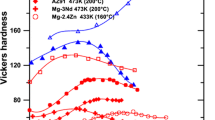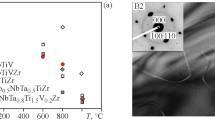Abstract
Alloying additions of Sc and Zr raise the yield strength of Al-Mg alloys significantly. We have studied the effects of Sc and Zr on the grain refinement and recrystallization resistance of Al-Mg alloys with the aid of computational alloy thermodynamics. The grain refinement potential has been assessed by Scheil–Gulliver simulations of solidification paths, while the recrystallization resistance (Zener drag) has been assessed by calculation of the precipitation driving forces of the Al3Sc and Al3Zr intermetallics. Microstructural performance indices have been derived, used to rank several alloy composition variants, and finally select the variant with the best combination of grain refinement and recrystallization resistance. The method can be used, with certain limitations, for a thermodynamics-based design of Al-Mg and other alloy compositions.













Similar content being viewed by others
References
V.I. Elagin, V.V. Zakharov, and T.D. Rostova: Metalloved. Termich. Obrab. Metallov., 1992, vol. 1, pp. 24–28.
Z. Yin, Q. Pan, Y. Zhang, and F. Jiang: Mater. Sci. Eng., A, 2000, vol. 280, pp.151–55.
Y.A. Filatov, V.I. Yelagin, and V.V. Zakharov: Mater. Sci. Eng., A, 2000, vol. 280, pp. 97–101.
K.L. Kendig and D.B. Miracle: Acta Mater., 2002, vol. 50, pp. 4165–4417.
J. Royset and N. Ryum: Int. Mater. Rev., 2005, vol. 50 (1), pp. 19–44.
V. Ocenasek and M. Slamova: Mater. Charact., 2001, vol. 47, pp.157–62.
F. Zeng, C. Xia, and Y. Gu: J. Alloys Compd., 2004, vol. 363, pp. 175–81.
B. Forbord, H. Hallem, and K. Marthinsen: Mater. Sci. Eng., A, 2004, vols. 387–389, pp. 936–39.
Y.W. Riddle and T.H. Sanders: Mater. Sci. Forum, 2000, vols. 331–337, pp. 939–44.
J.S. Vetrano, S.M. Bruemmer, L.M. Pawloski, and I.M. Robertson: Mater. Sci. Eng., A, 1997, vol. 238, pp. 101–07.
V.I. Elagin, V.V. Zakharov, and T.D. Rostova: Met. Sci. Heat Treat., 1992, vol. 1, pp. 37–45.
V.G. Davydov, T.D. Rostova, V.V. Zakharov, Y.A. Filatov, and V.I. Yelagin: Mater. Sci. Eng., A, 2000, vol. 280, pp. 30–36.
Y.W. Riddle, H. Hallem, and N. Ryum: Mater. Sci. Forum, 2002, vols. 396–402, pp. 563–68.
A. Pisch, J. Groebner, and R. Schmid-Fetzer: Mater. Sci. Eng., A, 2000, vol. 289A, pp. 123–29.
A.F. Norman, P.B. Pragnell, and R.S. McEwen: Acta Mater., 1998, vol. 46, pp. 5715–32.
C. Zener: Trans. Am. Inst. Min. Metall. Eng., 1946, vol. 167, pp. 551–95.
H.I. Aaronson and K.C. Russell: in Solid → Solid Phase Transformations, H.I. Aaronson, D.E. Laughlin, and C.M. Wayman, eds., TMS-AIME, Warrendale, PA, 1982, pp. 371–98.
B. Sundman, B. Jansson, and J.-O. Anderson: CALPHAD, 1985, vol. 9, pp. 153–90.
N. Saunders and A.P. Miodownik: CALPHAD: Calculation of Phase Diagrams, Pergamon, Oxford, UK, 1998, pp. 91–110.
G. Effenberg: COST 507: Definition of Thermochemical and Thermophysical Properties to Provide a Database for the Development of New Light Alloys. European Cooperation in the Field of Scientific and Technical Research, European Commission. Vol 1. Proceedings of the Final Workshop of COST 507, Vaals, the Netherlands, 1997. Vol 2. Thermochemical Database for Light Metal Alloys (I. Ansara, A.T. Dinsdale, and M.H. Rand, eds.). Vol 3. Critical Evaluation of Ternary Systems.
K. Janssens, D. Raabe, E. Kozeschnik, M.A. Miodownik, and B. Nestler: Comput. Mater. Eng., Elsevier Academic Press, Burlington, MA, 2007, pp. 28–30.
G. Cacciamani, P. Riani, G. Borzone, N. Parodi, A. Saccone, R. Ferro, A. Pisch, and R. Schmid-Fetzer: Intermetallics, 1999, vol. 7, pp. 101–08.
O. Redlich and A.T. Kister: Ind. Eng. Chem., 1948, vol. 40 (2), pp. 345–48.
Acknowledgments
This work has been partially supported by the Greek Secretariat of Research and Technology (Athens, Greece) under Grant No. 05PAV81. The authors thank Drs. D. Skarmoutsos of ELKEME (Athens, Greece) and D. Spathis of ELVAL (Oinofyta, Greece) for helpful suggestions.
Author information
Authors and Affiliations
Corresponding author
Additional information
Manuscript submitted October 1, 2009.
Appendix
Appendix
Introduction of Sc in the COST 507 light-alloy thermodynamic database
The present appendix presents the procedure for the introduction of Sc in the COST 507 thermodynamic database. This was necessary in order to carry out thermodynamic calculations involving Sc as an alloying element in Al-Mg alloys with Thermo-Calc software.
The fundamental thermodynamic properties of elemental Sc, i.e., a stable crystal structure, atomic mass, and standard element reference (SER) enthalpy and entropy are given in Table IV. The following descriptions of the molar Gibbs free energies of the intermetallic phases were retrieved from the literature:[22]
In Eqs. [A1] through [A4], G φ represents the molar Gibbs free energy of intermetallic phase φ, \( G_{\text{Al}}^{{^\circ ,{\text{fcc}}}} (T) \) and \( G_{\text{Sc}}^{{^\circ ,{\text{hcp}}}} (T) \) represent the Gibbs free energy of pure Al and pure Sc, respectively, at their stable crystal structure as a function of temperature, while T is the absolute temperature. The Gibbs free energies of pure Al and pure Sc as functions of temperature are given by the following equations:
-
1.
Al in the fcc phase
for 298 K ≤ T ≤ 700 K (25 °C ≤ T ≤ 427 °C):
for 700 K ≤ T ≤ 933 K (427 °C ≤ T ≤ 660 °C):
for T ≥ 933 K (T ≥ 660 °C):
-
2.
Sc in the hcp phase
for 298 K ≤ T ≤ 800 K (25 °C ≤ T ≤ 527 °C):
for 800 K ≤ T ≤ 1608 K (527 °C ≤ T ≤ 1335 °C):
for T ≥ 1608 K (T ≥ 1335 °C):
The corresponding mathematical description of the Gibbs free energy of solid-solution phases in the CALPHAD method is implemented by the Redlich–Kister–Mugiannu formalism.[23] According to this formalism, the molar Gibbs free energy of a nonstoichiometric phase φ is given by a relation of the following form:
In Eq. [A11], x i and x j represent the mole fractions of components i and j, respectively, \( G_{i}^{^\circ ,\phi } \) is the Gibbs free energy of pure component i, when existing in the crystal structure of phase φ (e.g., \( G_{\text{Al}}^{{^\circ ,{\text{fcc}}}} \), \( G_{\text{Sc}}^{{^\circ ,{\text{hcp}}}} \), etc.), while \( L_{i,j}^{u,\phi } \) are the interaction parameters of order u, through which the excess energy that arises from the fact that the solid-solution phase φ is not ideal is taken into account. The available interaction parameters for the Al-Sc binary system are listed here. Interaction parameters not contained in the list are taken to be equal to zero.
Finally, the relevant \( G_{i}^{^\circ ,\phi } \) parameters of Eq. [A11] are given here. It should be noted that parameters \( G_{\text{Al}}^{{^\circ ,{\text{fcc}}}} \) and \( G_{\text{Sc}}^{{^\circ ,{\text{hcp}}}} \) have already been described in Eqs. [A5] through [A10] and are not repeated here.
-
3.
Al in the liquid phase
for 298 K ≤ T ≤ 934 K (25 °C ≤ T ≤ 661 °C):
for T ≥ 934 K (T ≥ 661 °C):
-
4.
Sc in the bcc phase
for 298 K ≤ T ≤ 1000 K (25 °C ≤ T ≤ 727 °C):
for 1000 K ≤ T ≤ 1608 K (727 °C ≤ T ≤ 1335 °C):
for T ≥ 1608 K (T ≥ 1335 °C):
-
5.
Sc in the liquid phase
for 298 K ≤ T ≤ 1608 K (25 °C ≤ T ≤ 1335 °C):
for T ≥ 1608 K (T ≥ 1335 °C):
After retrieving the necessary thermodynamic data for the Al-Sc system, the data were incorporated in the COST 507 database. This modified COST 507+Sc database was then used in conjunction with Thermo-Calc software to calculate the binary Al-Sc system. The calculation was performed up to 50 at. pct Sc and is shown in Figure A1. The comparison with the published experimental binary Al-Sc[22] shows that the calculated diagram is in good agreement with the experimental one and, therefore, the modified COST 507+Sc database can be used for the thermodynamic calculations in this work.
Rights and permissions
About this article
Cite this article
Haidemenopoulos, G., Katsamas, A. & Kamoutsi, H. Thermodynamics-Based Computational Design of Al-Mg-Sc-Zr Alloys. Metall Mater Trans A 41, 888–899 (2010). https://doi.org/10.1007/s11661-009-0168-8
Published:
Issue Date:
DOI: https://doi.org/10.1007/s11661-009-0168-8





